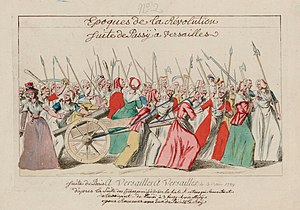
Back المسيرة النسائية إلى قصر فرساي Arabic Поход към Версай Bulgarian Devezhioù ar 5 hag ar 6 a viz Here 1789 Breton Marš na Versailles BS Jornades del 5 i 6 d'octubre de 1789 Catalan Ženský pochod na Versailles Czech Poissarden German Πορεία Γυναικών στις Βερσαλλίες Greek Women's March on Versailles English Marcha sobre Versalles Spanish
The English used in this article or section may not be easy for everybody to understand. |
| Women's March on Versailles | |||
|---|---|---|---|
| Part of the French Revolution | |||
 A contemporary illustration of the Women's March on Versailles, 5 October 1789 | |||
| Date | 5 October 1789 | ||
| Location | |||
| Parties to the civil conflict | |||
| Units involved | |||
| |||
The Women's March on Versailles was one of the earliest events of the French Revolution. It was also very important. Other names for the event are October March, October Days or simply March on Versailles. The march began on the morning of 5 October 1789. Women had gone to the marketplaces in Paris. When they became aware that the price of bread had increased once again, they nearly started a riot. There were also revoutionaries there. The revolutionaries had a political agenda: They wanted the state to become more liberal, and they also wanted to change the absolute monarchy into a constitutional one. The market women and their allies ultimately grew into a mob of thousands. They broke into the city armory, and stole weapons. Then they marched to the Palace of Versailles. The crowd besieged the palace, and successfully told their demands to King Louis XVI. The next day, the crowd forced the king, his family, and most of the French Assembly to return with them to Paris.
These events ended the king's independence. They were the start of a new balance of power. In the end, the established, privileged orders of the French nobility would lose their influence in favor of the common people, collectively known as the Third Estate. By bringing together people representing the sources of the Revolution in their largest numbers yet, the march on Versailles proved to be a defining moment of the Revolution.